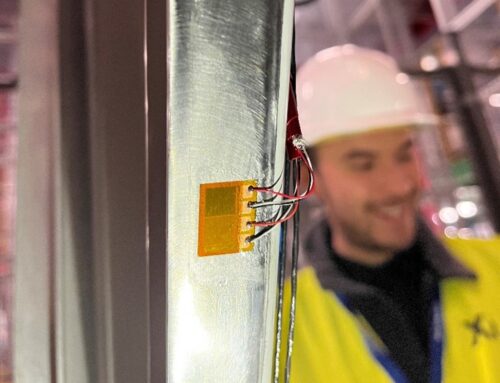Following on from our debate about Xi’s top engineering films, the team has debated (again) our top 5 Christmas films, but, this time we dig even deeper into the engineering aspect of them. Quantum mechanics, booby traps, Santa’s manufacturing process, Nakatomi tower shooting calculations and some very important health and safety tips to avoid electrocution from fairy lights!
We hope you find as much comfort and entertainment as we did! Merry Christmas and stay safe!
Die Hard (1988)
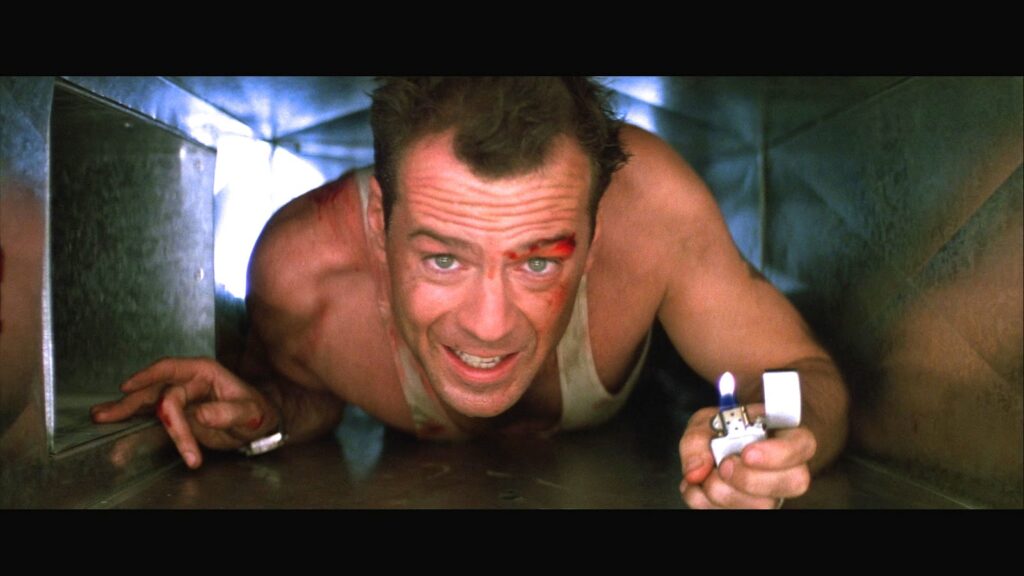
John McClane (Bruce Willis) get unwittingly caught up in a terrorist attack on the Nakatomi tower during an office Christmas party. Coming in the 80’s era of invincible, muscle-bound (often oiled up) action heroes in the mould of Arnie, Sly Stallone and van Damme, Die Hard redefined the genre by casting Bruce Willis to play a New York cop with real vulnerability due to his relationship with his estranged wife and his lack of shoes (and all that broken glass).
There is no argument that Die Hard is the greatest action movie ever made. Some argue that it isn’t really a Christmas movie – it is. But at Xi that is not what we argued about – we argued about whether Sgt Al Powell could have heard the firefight on the roof of Nakatomi tower when he was pulled up at the gas station. To remind you, Sgt Powell steps out into the street from the gas station and looks up at the skyscraper where you can clearly see muzzle flashes on the roof. So, shouldn’t he have been able to hear the gunshots?


The 150 m, 34 story Fox Plaza played the Nakatomi tower in the movie.
According to www.themoviedistrict.com, the gas station was at 10350 West Olympic Boulevard, LA. The distance from the gas station to the base of Fox Plaza is 669 m; taking into consideration the height of the tower, the line of sight distance from the rooftop firefight to Stg. Powell was therefore 685.6 m.
The weapon of choice used by Karl and his European mates was the Steyr AUG assault rifle, which has a sound power level ~ 160 dB. If we assume cylindrical spreading of the noise over a distant of 669 m, then the transmission loss would be 56.7 dB and the sound pressure level at the gas station would be 103.3 dB. That is still really loud (normal talking is 60-65 dB). So yes, Sgt. Al Powell should have heard the gunshots, put down the bag of twinkies and reported in the firefight.
By the way, there would have been around a 2-second delay between the muzzle flash and the arrival of the noise.
Nightmare Before Christmas (1993)
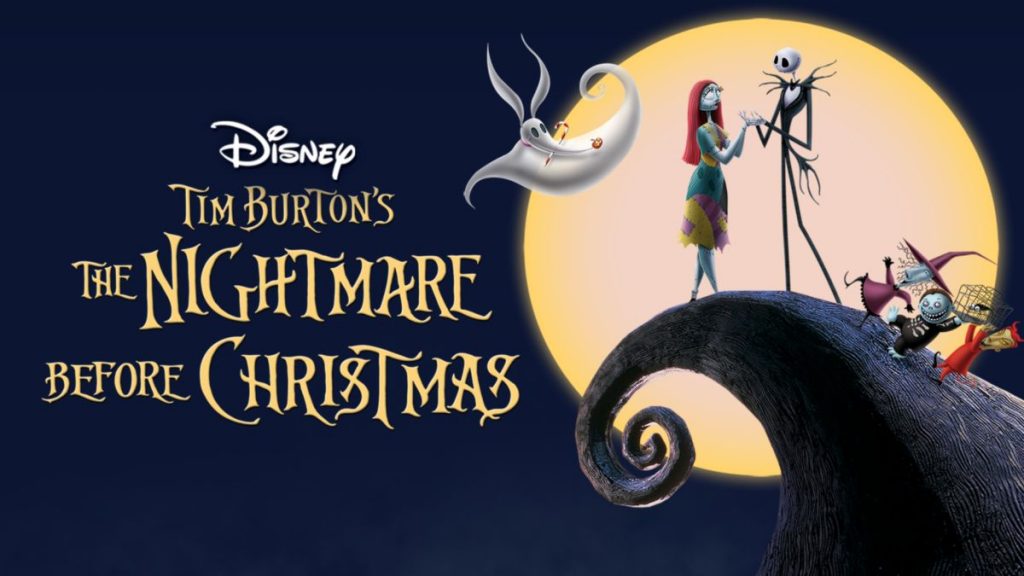
In The Nightmare Before Christmas, Jack Skellington, the Pumpkin King of Halloween Town, famously tires of perpetually organizing the same celebrations, year after year – the same monsters hiding under the bed, the same scary clowns, the same screaming pumpkins. Snooze. On a lonely walk through the forest he discovers a patch of trees with strange pictures on them: a bunny, a shamrock, a turkey… a tree with strange decorations on it? What’s This!? Jack takes a closer look and is suddenly transported into a strange new land… a place covered in sparkling snow, with toy trains, beautiful lights on all the trees and homes, children throwing snowballs (instead of throwing heads, you know…). Yes, Jack has arrived in a strange new place, perhaps even a different dimension… Christmas Town!
It’s possible that Jack has found a manifestation of the Many Worlds Interpretation of quantum mechanics, like others before and after him (Olivia and Peter, the crews of the Enterprise, Deep Space Nine and Discovery, Eleven and pals…)
The anecdote of Schrödinger’s Cat is famous and describes a cat in a box with a vial of poison. The vial may or may not have been broken by a hammer, which may or may not have been released by the decay of a radioactive particle – a decidedly quantum event. Thus, unless it is observed, the cat – a macroscopic object – is also in a superposition of being alive and being dead. This is a story the good folks of Halloween Town would certainly enjoy!
Erwin Schrödinger actually used this argument at the time to try and argue about the absurdity of this interpretation of quantum mechanics, the Copenhagen Interpretation, which asserts that a quantum system stays in a superposition of states until it is interacted with, i.e. observed, after which it “collapses” and is fixed into one of its many possible states (this actually is the orthodox interpretation). Einstein himself also argued at one point against this view, supposedly saying that God does not play dice with the universe. Oogie Boogie, however, certainly does, as Santa Claus distressingly comes to find out.
The Many Worlds Interpretation of quantum mechanics was introduced as an alternative to the Copenhagen Interpretation, arguing that the evolution of reality is in fact pre-determined, but that all possible outcomes of all possible events exist in diverging parallel universes or quantum worlds – a sort of “universal wave function”. This idea was first proposed by the physicist Hugh Everett in 1957, but was perhaps best expressed in Jack Skellington’s research via the following equation:
In The Nightmare Before Christmas, Jack Skellington, the Pumpkin King of Halloween Town, famously tires of perpetually organizing the same celebrations, year after year – the same monsters hiding under the bed, the same scary clowns, the same screaming pumpkins. Snooze. On a lonely walk through the forest he discovers a patch of trees with strange pictures on them: a bunny, a shamrock, a turkey… a tree with strange decorations on it? What’s This!? Jack takes a closer look and is suddenly transported into a strange new land… a place covered in sparkling snow, with toy trains, beautiful lights on all the trees and homes, children throwing snowballs (instead of throwing heads, you know…). Yes, Jack has arrived in a strange new place, perhaps even a different dimension… Christmas Town!
It’s possible that Jack has found a manifestation of the Many Worlds Interpretation of quantum mechanics, like others before and after him (Olivia and Peter, the crews of the Enterprise, Deep Space Nine and Discovery, Eleven and pals…)
The anecdote of Schrödinger’s Cat is famous and describes a cat in a box with a vial of poison. The vial may or may not have been broken by a hammer, which may or may not have been released by the decay of a radioactive particle – a decidedly quantum event. Thus, unless it is observed, the cat – a macroscopic object – is also in a superposition of being alive and being dead. This is a story the good folks of Halloween Town would certainly enjoy!
Erwin Schrödinger actually used this argument at the time to try and argue about the absurdity of this interpretation of quantum mechanics, the Copenhagen Interpretation, which asserts that a quantum system stays in a superposition of states until it is interacted with, i.e. observed, after which it “collapses” and is fixed into one of its many possible states (this actually is the orthodox interpretation). Einstein himself also argued at one point against this view, supposedly saying that God does not play dice with the universe. Oogie Boogie, however, certainly does, as Santa Claus distressingly comes to find out.
The Many Worlds Interpretation of quantum mechanics was introduced as an alternative to the Copenhagen Interpretation, arguing that the evolution of reality is in fact pre-determined, but that all possible outcomes of all possible events exist in diverging parallel universes or quantum worlds – a sort of “universal wave function”. This idea was first proposed by the physicist Hugh Everett in 1957, but was perhaps best expressed in Jack Skellington’s research via the following equation:

This interpretation proposes that there’s nothing special about an observer and an observed thing. Consider an observer (say a microscope) and an observed object (say a holly berry). The Many Worlds Interpretation says that the observer and the observed interact and can only be described by a relative state with respect to each other – Jack has either lowered the microscope too much and squashed the berry on the slide… or not. They cannot be described in a universally independent way. This leads to a branching of the timeline, resulting in a parallel superposition of alternate histories in which the berry is both squished and not squished. Subsequent measurements in the time history yield further branching (insert botanical pun here). This eliminates the special status of the observer and discards the ad hoc mechanism of waveform collapse (or hypothetical holly berry collapse). As a fan of games of chance, Dr. Oogie Boogie was certainly not a fan of this description of quantum mechanics. He was forced, however, to retract several publications, as it was found he had been loading the dice.
Anyway – travelling between the universes seems to be a challenge, so it’s also possible that Jack found a door between multiverses, another hypothesis in which multiple universes were created in multiple big bangs but are “physically” separated from our own in a process described as Cosmic Inflation (Note to Jack: big bangs are very startling – perfect for Halloween festivities!). Cosmic Inflation posits that the entire universe/multiverse is a quantum entity with all of the associated quantum fields and waveforms and uncertainties. Because of this, it appears that inflation from the big bang may end at different times in different regions across the vastness of space, while in other regions space may contract, leading to new big bangs. The different regions can’t actually interact with each other because space itself is expanding, separating them for eternity. It would be difficult for even the brilliant but mad Dr. Finkelstein to wrap his (exposed) brain around that idea; perhaps all of those Christmas lights are actually a string theory that makes it all work…
On a slightly different note, we at Xi are proud to announce that we’re now using COMSOL’s new software package – COMSOL Metaphysics. If you’re confused about the fundamental nature of reality, we can help! We’re particularly excited about the Epistemology Module with it’s new Anthropic Principle functionality. (Oh wait, wrong holiday – that’s April Fools…).
Home Alone (1990)

Kevin McCallister (Macaulay Culkin) gets left at home when his family head to Paris for Christmas. For many it’s an all-time Christmas favourite, but things get interesting from an engineering point of view when Kevin starts building booby traps to defeat a pair of cat burglars who try to break into the house. The cat burglars Harry (Joe Pesci) and Marv (Daniel Stern) take a lot of punishment, including being shot by BB guns, electrocuted, blow torched and being attacked by a tarantula. One of the most famous booby traps is the paint can pendulum that Kevin swings from the second-floor landing down a staircase and directly into the burglars’ faces. How fast was the can moving when it connected with Marv’s melon?
The cans are tied to the second-floor bannister which we can assume is 6 m above the ground floor. Marv is on the fourth step when he gets tanned in the face, so his feet are 0.8 m above the ground. Daniel Stern was a big bloke at 6 foot 4 inches or 1.93 m. If the centre of mass of the can hit him on the nose around 0.2 m below the top of his head, then the bottom of the pendulum would have been 2.53 m above the ground (0.8 + 1.93 – 0.2 = 2.53 m) and the length of the pendulum would therefore be 3.47 m.
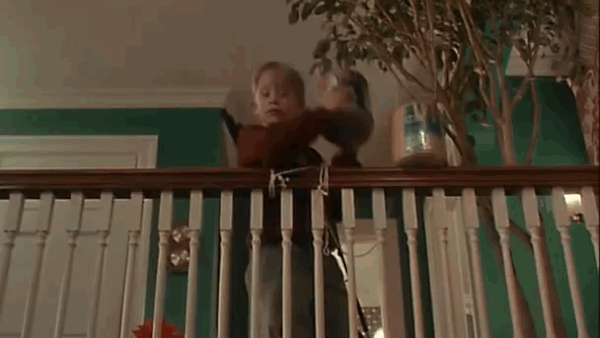
Assuming the 5-litre paint can was full, it would weigh 5.1 kg. If Kevin released the can from stationary at the top of the pendulum, the potential energy (PE = mgh) would have been 5.1kg x 9.8m/s2 x 3.47 m = 173.4 J. All that energy would be converted to kinetic energy as it hit Marv’s scone (KE = ½ m v2) and the velocity would have been 8.25 m/s (29.7 km/hr). The transfer of that amount of energy into Marv’s face would likely not be fatal, but would certainly be sufficient to break multiple face bones including the jaw and cheekbones. The rapid acceleration of the brain on impact would knock Marv out cold resulting in a concussion or worse. It would definitely be a sore one.
Santa Claus: The Movie (1985)
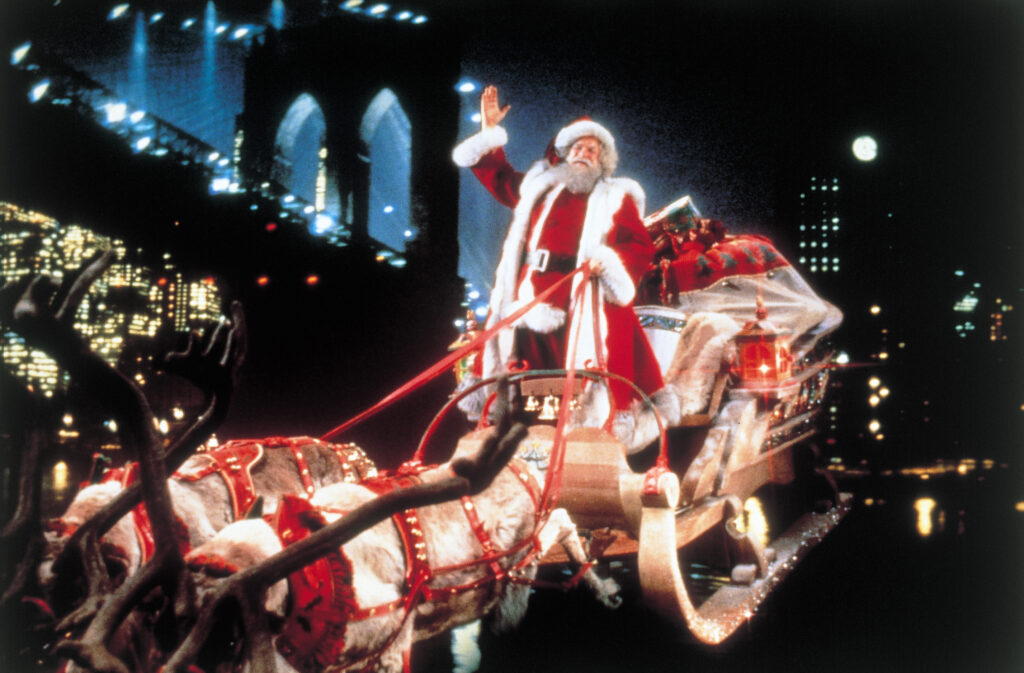
When considering the engineering in of Santa Claus The Movie, it would be tempting to consider the levitation properties of the reindeer and the magical candy canes. However, levitation is, of course, preposterous at the scale addressed in Santa Claus The Movie, rather the film is really an engineering tale about an overworked Santa Claus and an altruistic toy firm struggling with production demands. It could equally be called “Production Engineering The Movie”
After 5 centuries of producing toys for the World’s children, the pressures are taking their toll on the man in red. Interestingly, and not directly addressed on screen, is the population boom during Santa’s career, in the 14th century when Santa took his role, the World’s population was 350 million, at the time of the film’s release in 1985 was close to 5 billion [1], a 14 fold increase. One wonders if his employment contract addressed this possibility, but it highlights only one of the many unforeseen engineering challenges a growing Earth population has.
Of course, in the film Santa employs Patch, played by Dudley Moore, to improve his manufacturing process. Patch is very successful with his innovative improvements to the toy production line. However, in a display of poor management Santa is unimpressed with the teething issues, which he really should have predicted with such major overhauls, and Patch is dismissed.
The film then addresses the caution engineers must face in the world of corporate greed when patch meets B.Z, played superbly by John Lithgow. B.Z is quick to see the value in Patch’s engineering innovations and the board of his toy firm push his new product to market. Of course, for B.Z profit is his primary goal. So, the eventual product launch goes ahead without due engineering diligence, and as an unsurprising result, to explosive consequences.
A cautionary engineering Christmas tale indeed.
National Lampoon’s Christmas Vacation (1989)
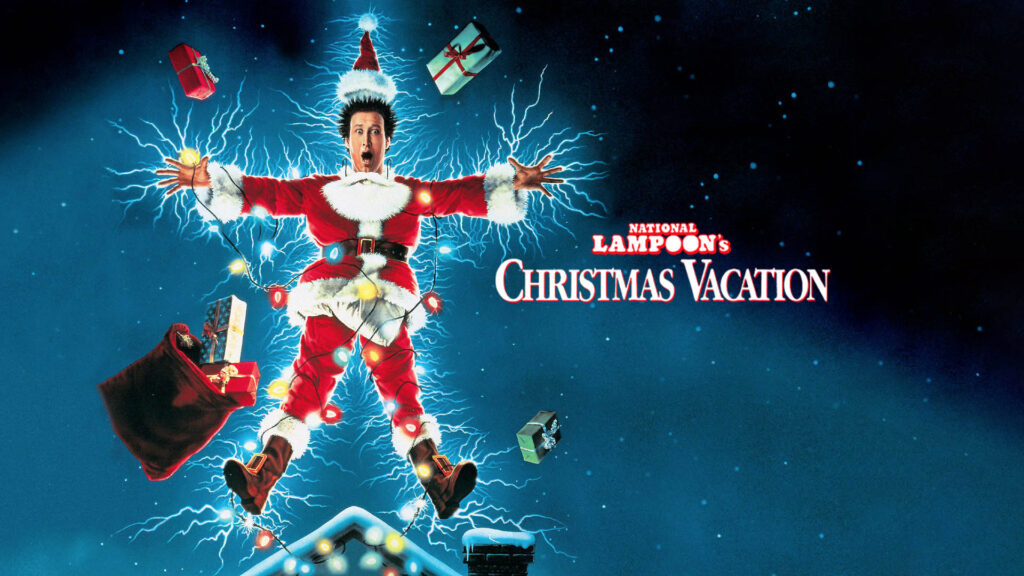
An excellent reminder for us to revisit a few of our favourite best practice and Health and Safety tips as recommended by our measurement team:
- When carrying out fieldwork – make sure to plan and complete a pre-site checklist
- When you get to the site, have an all-team safety moment.
- As exemplified here – check your wiring! We doubt those fairy lights had been PAT tested.
- They also might have benefited from a hard hat to protect against un-identified falling objects (sleighs) overhead
- Refer back to, and, update the RAMS (risk assessment and method statement) and circulate as appropriate, yes even to the elves and grumpy in-laws.
- And, finally, when packing up for next year – be sure to coil your wires correctly – a particular passion of some of our engineers!
We hope you have a happy, safe and well-lit festive period!
